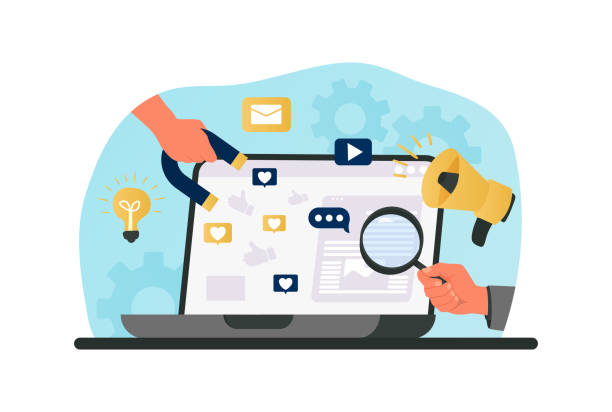Introduction to the Importance of Secure Website Design in Today’s Digital World

In the current era, where the internet forms the backbone of #modern_businesses and our daily interactions, #secure_website_design is more than an option; it’s an absolute necessity.
With the increasing proliferation of cyber threats, every website, from a simple personal blog to large #e-commerce platforms, is exposed to various attacks.
Ignoring the principles of secure website design can lead to the loss of sensitive data, damage to business reputation, and even heavy financial penalties due to user privacy breaches. In this regard, understanding how to create a secure website is vital for every business owner or web developer.
This process is not limited to merely installing an SSL certificate but requires a comprehensive approach that covers all layers of the website, from server infrastructure to front-end coding.
In fact, website security should be considered from the very initial stages of project design and planning, rather than being an additional feature added later.
A website that adheres to secure website design principles not only protects sensitive user and business information but also earns their trust and provides a better user experience.
This descriptive introduction is the starting point for a deeper exploration of various aspects of web security and how to implement it effectively.
Are you tired of your company’s website not being seen as it deserves, losing potential customers? Solve this problem forever with professional and effective website design by Rasawp!
✅ Increase brand credibility and gain customer trust
✅ Attract targeted sales leads
⚡ Contact us now for a free consultation!
Identifying and Counteracting Common Web Security Threats

To achieve a secure website design, a precise understanding of common threats faced by websites is essential.
These threats are diverse, and each requires a specific approach to counter them.
One of the most common attacks is SQL injection, through which attackers can inject malicious SQL commands into the website’s database to extract or manipulate sensitive information.
XSS (Cross-Site Scripting) attacks also allow attackers to execute malicious scripts in users’ browsers, which can lead to the theft of cookies or user account information.
CSRF (Cross-Site Request Forgery) attacks are another type of attack where an attacker, by deceiving the user, forces them to execute unwanted requests on a website they were previously logged into.
Furthermore, DDoS (Distributed Denial of Service) attacks aim to disable the website by sending a massive volume of malicious traffic.
To counteract these threats, numerous specialized approaches exist; from precise input validation and the use of prepared statements in database queries to prevent SQL injection, to filtering outputs and using HTTP security headers to combat XSS and CSRF. Implementing a Web Application Firewall (WAF) can also significantly help in identifying and blocking malicious traffic.
This specialized analysis of threats is a crucial step towards strengthening website security and creating a secure web design that is resilient against cyber attacks.
Key Principles of Secure Coding and Vulnerability Prevention

The mastermind behind any website is its code, and secure coding is the cornerstone of secure website design.
Many security vulnerabilities stem from programming errors that can be prevented by adhering to specific principles.
The first and perhaps most important principle is Input Validation.
Any data received from the user must be carefully checked and sanitized to prevent the injection of malicious code or data.
This includes checking the data type, length, format, and content.
Furthermore, using ORM (Object-Relational Mapping) and Prepared Statements for database interaction, instead of manually building queries, significantly reduces the risk of SQL injection attacks.
Encrypting and hashing sensitive information, especially passwords, instead of storing them as plain text, is another vital principle.
Using strong hashing functions like bcrypt or Argon2 and adding Salt to hashes dramatically increases password security.
Additionally, proper error and exception handling is of great importance.
Displaying generic error messages to users instead of technical details that could be exploited by attackers is essential.
Implementing HTTP security policies such as CSP (Content Security Policy) and X-Frame-Options can prevent XSS and Clickjacking attacks.
Regularly updating the libraries and frameworks used is also very important, as older versions often have known vulnerabilities that can be exploited. This is an educational approach that encourages developers to adhere to best practices at every stage of the software development lifecycle.
These fundamental measures ensure secure coding and ultimately a secure and reliable website design.
| Technique | Purpose | Description |
|---|---|---|
| Input Validation | Preventing Injection and XSS Attacks | Inspecting, filtering, and sanitizing all user input data before use. |
| Prepared Statements/ORM | Combating SQL Injection | Separating SQL command logic from data to prevent data from being interpreted as code. |
| Password Hashing and Salting | Protecting Authentication Information | Storing passwords as hashed values with random salts and strong hashing functions. |
| Secure Error Handling | Hiding Sensitive Information | Displaying generic error messages to the user and logging details for the administrator. |
| Updating Libraries | Fixing Known Vulnerabilities | Always use the latest stable and secure versions of frameworks and libraries. |
The Crucial Role of SSL/TLS Certificates and HTTPS Protocol in Web Security
![]()
On the path to achieving secure website design, the use of SSL/TLS certificates and the HTTPS protocol is one of the first and most crucial steps to take.
These technologies play a vital role in encrypting communications between the user’s browser and the website server.
Simply put, when you visit a website with HTTPS, all data exchanged between you and the website (such as login information, credit card details, or personal messages) is encrypted in such a way that it becomes unreadable if intercepted by third parties.
SSL (Secure Sockets Layer) and TLS (Transport Layer Security) certificates, with TLS being the newer and more secure version of SSL, authenticate the server’s identity and establish a secure communication channel. This prevents attacks such as “Man-in-the-Middle” where an attacker attempts to intercept communications between the user and the server to eavesdrop or tamper with data.
In addition to the security aspect, using HTTPS also offers other benefits.
Modern browsers like Chrome flag websites that do not use HTTPS as “insecure,” which can negatively impact user trust and conversion rates.
Furthermore, search engines like Google consider HTTPS as a positive ranking factor, which can help improve your website’s SEO.
These protocols are an integral part of any secure website design strategy, not only protecting information from interception but also demonstrating the website’s commitment to user privacy and creating a safe online environment. This is essential guidance for anyone looking to enhance their website’s security and credibility, directly impacting its online reputation and success.
Does your company’s website perform as befits your brand? In today’s competitive world, your website is your most important online tool. RasaWeb, a specialist in professional corporate website design, helps you to:
✅ Gain credibility and customer trust
✅ Convert website visitors into customers
⚡ Get a free consultation!
Protecting Databases and User Information in Web Design

The database is the beating heart of any website, storing vital user information, content, and transactions.
Therefore, protecting it is of paramount importance in the secure website design process. Database intrusion can lead to the theft of personal information, passwords, banking details, and even data manipulation, which would have disastrous consequences for both the business and its users.
The first step in database security is adhering to the “Principle of Least Privilege;” meaning that database users and applications are granted only the minimum access necessary to perform their tasks.
For example, a website user who needs to read their profile information does not need access to delete entire tables.
The use of encryption for sensitive data stored in the database, especially financial and personal information, is essential.
Even if an attacker infiltrates the database, encrypted data will be useless to them.
Furthermore, ensuring that all communications with the database occur over secure and encrypted channels (such as SSL/TLS) is crucial.
This aspect is highly specialized and important for secure website development.
Regularly updating the Database Management System (DBMS) is also important to address known vulnerabilities.
Moreover, implementing robust mechanisms to counter SQL injection attacks, such as using Prepared Statements and filtering all inputs, are key measures.
Monitoring and logging database activities to identify suspicious patterns and intrusion attempts is also an important aspect of database security. Ultimately, ensuring the database and user information is an integral part of a comprehensive and effective secure website design.
Web Application Firewalls (WAF) and Intrusion Detection Systems (IDS) for Enhanced Security

In the realm of secure website design, the use of Web Application Firewalls (WAF) and Intrusion Detection Systems (IDS) provides vital defensive layers to protect the website against complex attacks.
A WAF acts as a protective shield between your website and the internet, filtering and monitoring HTTP/S traffic.
This firewall can identify and block common web attacks such as SQL injection, XSS, and bot attacks.
A WAF can be implemented as hardware, software, or cloud-based, and it identifies threats by analyzing traffic patterns and matching them against predefined security rules or machine learning models.
Intrusion Detection Systems (IDS) are also tools that monitor network or system activities to identify suspicious activities or policy violations.
An IDS can operate based on signatures (identifying known attack patterns) or anomalies (identifying unusual behaviors that may indicate an attack).
The main difference between an IDS and an Intrusion Prevention System (IPS) is that an IDS only alerts, while an IPS can actively block attacks.
Implementing these systems as part of an analytical approach to secure website design allows website administrators to quickly become aware of intrusion attempts and take necessary countermeasures. These tools are especially vital for large websites and organizations that handle a high volume of traffic and sensitive data.
The use of WAF and IDS, as supplements to security measures at the coding and server levels, provides a comprehensive strategy for enhancing website security.
The Importance of Continuous Updates and Security Patch Management

One of the most important, yet often overlooked, aspects of secure website design is its continuous maintenance and updating.
Software used on a website, from the server operating system to content management systems (CMS), plugins, themes, and coding libraries, are constantly evolving.
However, with this evolution, new security vulnerabilities are also discovered.
Hackers are constantly looking for these weaknesses to exploit them.
Therefore, timely installation of security patches and updating to the latest software versions is vital. Delays in this process can make your website vulnerable to attacks for which solutions already exist.
This is a news-oriented approach, as news about new vulnerabilities and security patches is continuously published.
Patch Management should become a regular and planned process.
This includes continuous monitoring for new patch releases, testing them in a non-production (staging) environment to ensure they don’t disrupt website functionality, and then applying them to the main environment.
Many CMSs like WordPress, Joomla, and Drupal regularly release security updates, and failing to install them quickly can put the website at risk.
In addition to the CMS core, plugins and themes must also be carefully updated, as they are often primary sources of vulnerabilities.
This is a key guideline for maintaining continuous website security and helps ensure that your secure website design remains resilient against new threats. This ongoing practice is essential for any website seeking long-term stability and security.
| Step | Description | Importance in Secure Website Design |
|---|---|---|
| Monitoring and Identification | Regularly checking for new security patch releases for all website components (OS, CMS, plugins, libraries). | The first step to being aware of newly discovered vulnerabilities. |
| Patch Testing | Installing and testing patches in a test (staging) environment before applying them to the live environment. | Preventing disruption to the main website’s functionality and the emergence of new problems. |
| Patch Application | Deploying patches on the server and main website after ensuring stability. | Addressing vulnerabilities and strengthening website security. |
| Review and Verification | Checking after patch application to ensure proper functionality and absence of issues. | Ensuring the process was successful and maintaining system integrity. |
Regular Backups and Disaster Recovery Planning

Even with the best secure website design approaches, there’s always a possibility of disaster.
This disaster could include a successful cyber attack, human error, hardware failure, or even natural disasters.
In such circumstances, having a regular backup strategy and a comprehensive Disaster Recovery Plan becomes critically important.
Regular backups allow you to restore your website to its state before an incident occurred, in case of data loss. This not only includes database data but also website files, images, custom code, and server configurations.
It is recommended that backups be stored in various locations; both on cloud servers independent of the main server and offline.
This practice minimizes the chance of simultaneous loss of backups with the main website.
The backup frequency should also be proportionate to your website’s data change rate; for websites with dynamic content and many transactions, daily or even multiple backups per day are essential.
A disaster recovery plan should include detailed steps for restoring the website from backups, defining roles and responsibilities, and an estimated timeline for returning to normal operations.
This guidance approach ensures that even in the worst-case scenarios, your online business can quickly become operational and prevent long-term losses. This crucial step in secure website design provides you with peace of mind and ensures your website’s long-term stability.
Are you losing business opportunities because of an outdated website? With RasaWeb, solve the problem of not attracting potential customers through your website forever!
✅ Attract more high-quality leads
✅ Increase brand credibility in the eyes of customers
⚡ Get a free corporate website design consultation
User Education and the Importance of Personal Cyber Security Adherence

Up to this point, we have mostly discussed the technical aspects of secure website design, but another crucial link in the security chain is the users themselves.
Even the most secure infrastructures and coding can be vulnerable to human error.
Therefore, educating users and raising their awareness of the importance of personal cybersecurity adherence is a vital and perhaps even engaging part of a comprehensive security approach.
An unaware user who enters their login information on phishing pages, or uses weak and reused passwords, can easily open the door for attackers to infiltrate.
User education should include topics such as recognizing phishing emails and scam messages, the importance of using strong and unique passwords for each service, and enabling Two-Factor Authentication (Two-Factor Authentication – 2FA).
Furthermore, users should be aware of the risks of clicking on unknown links or downloading files from untrusted sources.
These trainings can be provided through educational articles on the website, informational emails, or even short videos and engaging infographics.
Encouraging users to use antivirus software and regularly update their operating systems and browsers is also important.
This is an educational approach that not only strengthens your website’s security but also helps create a more aware and secure online community. This collective awareness contributes significantly to the overall success of cybersecurity and complements all technical efforts for secure website design.
Periodic Security Audits and Penetration Testing for Continuous Evaluation

After implementing all measures related to secure website design, the work is not yet finished.
Cyber threats are constantly evolving, and new vulnerabilities may be discovered.
Therefore, conducting periodic Security Audits and Penetration Testing is crucial for continuously evaluating and strengthening your website’s security.
A security audit is a comprehensive review of all aspects of website security, including server configuration, coding, access policies, and security processes. This audit can include manual code review to identify vulnerabilities and ensure adherence to best security practices.
Penetration testing, often known as “ethical hacking,” goes a step further.
In penetration testing, security experts use techniques and tools similar to real hackers to attempt to infiltrate your website.
The goal is to discover vulnerabilities that might be overlooked during traditional audits.
This includes attempts to find SQL injection, XSS, misconfigured servers, and other weaknesses.
The results of penetration testing provide a detailed report of discovered vulnerabilities and recommendations for remediation.
This is an analytical and thought-provoking approach, as the question of whether our system is secure enough always arises. Regularly conducting these tests helps organizations ensure their readiness against attacks and continuously improve their cybersecurity.
These processes ensure that your secure website design remains secure over time.
Frequently Asked Questions
| Row | Question | Answer |
|---|---|---|
| 1 | What is secure website design? | The process of designing and developing websites that are resilient against cyberattacks and protect user data and privacy. |
| 2 | Why is website security important? | To prevent data breaches, financial losses, damage to company reputation, and maintain user trust. |
| 3 | What are some common website security threats? | SQL Injection, XSS (Cross-Site Scripting), CSRF (Cross-Site Request Forgery), weak authentication, and outdated software. |
| 4 | What are SSL/TLS and what is their role? | Protocols for encrypting data between the user’s browser and the website server, ensuring secure and private communication. |
| 5 | How can SQL Injection attacks be prevented? | By using Prepared Statements/Parameterized Queries, input validation, and ORMs (Object-Relational Mappers). |
| 6 | What is the role of a Web Application Firewall (WAF) in security? | A WAF monitors and filters HTTP traffic between a web application and the internet to prevent malicious attacks. |
| 7 | Why is regular updating of software and libraries essential? | Updates include patches for known security vulnerabilities that attackers can exploit. |
| 8 | How can XSS attacks be prevented? | By sanitizing and escaping all user inputs before displaying them on the web page and using Content Security Policy (CSP). |
| 9 | What does the Principle of Least Privilege mean? | It means that users and systems are granted only the minimum necessary permissions to perform their tasks, to prevent unnecessary access to resources. |
| 10 | What is the importance of proper user session management? | To prevent session hijacking and unauthorized access to user accounts through secure and expiring session tokens. |
And other services of RasaWeb advertising agency in the field of advertising
Smart Sales Automation: An innovative platform to improve click-through rates by optimizing key pages.
Smart Digital Branding: Revolutionize campaign management with the help of key page optimization.
Smart Data Analysis: A dedicated service for growing customer acquisition based on attractive UI design.
Smart Digital Advertising: An effective tool for online growth through key page optimization.
Smart Conversion Rate Optimization: An effective tool for improving SEO rankings with the help of key page optimization.
And over hundreds of other services in internet advertising, advertising consultation, and organizational solutions
Internet Advertising | Advertising Strategy | Advertorial
Resources
10 Tips for Increasing Website SecurityThe Importance of SSL Certificates in Site SecuritySolutions for Preventing Cyber Attacks on WebsitesSecure Coding Principles for Web Developers
❓ With Rasawp Afarin, your business will be transformed in the digital world; from secure website design to targeted marketing, we are with you.
📍 Tehran, Mirdamad Street, next to Bank Markazi, Kazeroon Janubi Alley, Ramin Alley, No. 6

